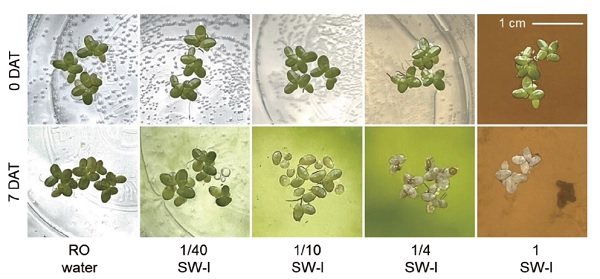All issues

Author:Bo-Wen Lin, Shu-Chen Chang*, Yahn-Chir Lee, Chi-Ling Chen, and Hsien-Tzung Shih
Abstract:
Duckweed, a plant rich in protein contents, is commonly used for wastewater purification in various industries, livestock farming, food processing, and domestic applications because it can effectively remove nitrogen and phosphorus from water bodies. In this study, we evaluated the growth performance of dotted duckmeat (Landoltia punctate) cultivated in swine wastewater (SW-I and SWII) and investigated its growth rate in a potential coastal fish farm setting. In the tolerance assessment, dotted duckmeat was cultivated in SW-I diluted with different volumes of reverse osmosis (RO) water, resulting in a 27−52% reduction in SW-I electrical conductivity (EC) and an increase in pH to 9.1–9.9 after one week. SW-I at 40× dilution in RO water significantly promoted the growth of dotted duckmeat, by increasing its fresh weight by 1.7 times. When local groundwater with an EC value of 1,696 μS cm-1 was used to dilute SW-II into different volumes for cultivation experiments, it was predicted that the best fresh weight would be achieved at 70.6 times the volume of SW-II. Moreover, at 109.9 times the volume of SW-II, the healthy leaf area percentage reached 92.5%, comparable to dotted duckmeat cultivated in pure groundwater. When different quantities of dotted duckmeat were introduced into drainage baskets in a coastal fish farm, the best growth performance was observed when 30% of the initial growth area was added during cultivation period II, with a growth rate reaching 2.8 mg cm-2 d-1 within 1 wk, especially in periods characterized by higher daily mean temperatures and lower daily mean wind speeds. These results provide valuable insights into the future commercial production of dotted duckmeat, with potential applications in animal feed and biofuel production.
Key words:Duckweed, Circular agriculture, Bioremediation, Alternative proteins
Download:![]() PDF Links
PDF Links
- 1. Using Digital Soil Mapping to Predict Soil Organic Carbon Stocks in Zhuoshui River Basin
- 2. Taxonomic Review of the Genus Asiophrida Medvedev, 1999 in Taiwan (Insecta: Coleoptera: Chrysomelidae: Galerucinae: Alticini), with Notes on Biology
- 3. Development of a Technique for Forecasting (or Pre-Detection) Anthracnose Disease Incidences of Green Mature Bagging Mango Fruits
 Submit your manuscript
Submit your manuscript
 Guide for authors
Guide for authors